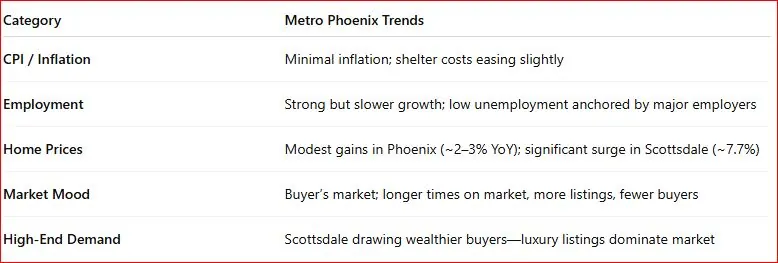1. Consumer Price Index (CPI) – Phoenix Metro Area
- As of June 2025, the CPI for Phoenix–Mesa–Scottsdale rose 0.2% year‑over‑year, with core CPI (excluding food & energy) up just 0.1% annually.
- Notably, shelter costs declined by 0.7%, signaling easing pressure in one of the most critical components for housing affordability.
Implication for real estate:
- The modest inflation and decline in shelter costs help ease affordability—meaning mortgage payments and housing-related expenses aren’t ballooning rapidly, which reduces urgency to raise asking prices.
- This, combined with a plateauing of CPI, has contributed to a market where price growth is slowing—favoring buyers and balancing previously overheated conditions.
2. Employment & Unemployment Trends
Unemployment Rates
- In June 2025, Phoenix’s unemployment rate stood at approximately 3.9% (non-seasonally adjusted)—rising slightly from 3.6% a month earlier, yet still well below the long-term average of 5.34%.
- Smoothed data from the same period shows a similar 3.6% rate, reinforcing the picture of a tight labor market.
Job Market Momentum
- Arizona’s job growth is decelerating: from about 1.2% in 2024 to an expected 1.0% in 2025, before picking up again in 2026–2027.
- Metro Phoenix experienced a net loss of 7,500 jobs over the prior 12 months, but experts view this as “statistically insignificant”, with the strong job ecosystem quickly absorbing displaced workers.
- Population growth remains robust, continuing to support long-term housing demand and the inflow of new residents.
Implication for real estate:
- Low unemployment and steady jobs maintain housing demand and confidence in purchases.
- While growth is slowing slightly, job and population fundamentals remain healthy, helping avoid sharp demand slumps.
- Builders and investors remain active, especially with large-scale developments and relocation projects fueling long-term housing needs.
3. How These Factors Intersect in the Phoenix Real Estate Market
Here’s how CPI and employment trends are playing out on the ground:
- Market Cooling & Buyer Leverage:
- Declining shelter CPI and rising wage pressure (job growth slowing) are reducing urgency for sellers to push prices—and dampening inflation-driven housing costs.
- This shift manifests in price corrections, longer days on the market, and growing inventory.
- Affordability Improvements:
- With shelter costs down and inflation more manageable, financially prepared buyers get better entry points into the market.
- Wage growth, including a noted 9.3% YoY rise, is outpacing inflation, creating affordability gains for specific segments.
- Job Market Resilience:
- A tight labor market with 3.9–3.6% unemployment, combined with corporate investments (e.g., TSMC “city within a city”) and population growth, sustains housing demand.
- Balanced Market Outlook:
- With inflation under control and employment stable, the possibility of a crash is low. Instead, Phoenix is settling into a balanced correction mode—prices are easing, but the market fundamentals remain secure.
Summary Snapshot

Final Takeaway
In 2025, Phoenix real estate is navigating a prudent rebalancing rather than a freefall. The moderate CPI increases and easing shelter costs are boosting affordability, while low unemployment and foundational economic strength maintain demand.
This dynamic presents a window of opportunity for buyers, particularly savvy, well-positioned ones. Sellers—especially at the upper end—may need to adjust expectations. And investors can find potential in long-term product demand, especially in rental and built-to-rent sectors, driven by continued population and job growth.






